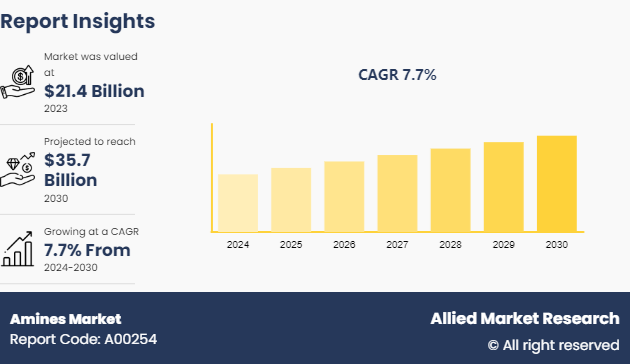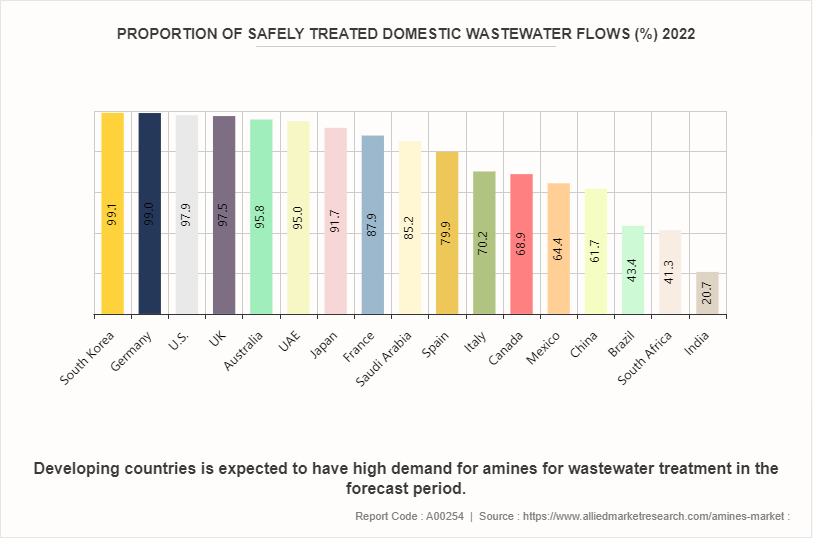Amines Market
P
2024
Amines Market Size, Share, Competitive Landscape and Trend Analysis Report, by Type, by Application : Global Opportunity Analysis and Industry Forecast, 2024-2030
Amines Market Research, 2030
The global amines market was valued at $21.4 billion in 2023, and is projected to reach $35.7 billion by 2030, growing at a CAGR of 7.7% from 2024 to 2030.

Market Introduction and Definition
Amines are organic compounds derived from ammonia (NH₃) by replacing one or more hydrogen atoms with alkyl or aryl groups. They are categorized into primary (one alkyl or aryl group) , secondary (two groups) , and tertiary amines (three groups) . Amines possess a lone pair of electrons on the nitrogen atom, which makes them basic and nucleophilic.
Applications of amines are vast and diverse. In the pharmaceutical industry, they are foundational in synthesis of drugs, including analgesics and antihistamines. In agriculture, amines are used to produce pesticides and herbicides. They also play a crucial role in manufacturing dyes, rubber processing chemicals, and water treatment solutions. In organic chemistry, amines are essential intermediates in various synthesis reactions. Furthermore, amines serve as catalysts and solvents in industrial processes, highlighting their significance in chemistry's practical and theoretical aspects.
Key Takeaways
- The amines market study covers 20 countries. The research includes a segment analysis of each country in terms of value for the projected period.
- More than 1,500 product literature, industry releases, annual reports, and other documents of major valine industry participants, authentic industry journals, trade associations' releases, and government websites have been reviewed for generating high-value industry insights.
- The study integrated high-quality data, professional opinions and analysis, and critical independent perspectives. The research approach is intended to provide a balanced view of global markets and to assist stakeholders in making educated decisions to achieve the most ambitious growth objectives.
Market Dynamics
The amines market is propelled by several key drivers, including increase in demand for amines in pharmaceuticals. Amines are crucial intermediates in drug synthesis, essential for the production of a wide array of medications, including analgesics and antihistamines. This demand is anticipated to grow steadily as the healthcare sector innovates and develops new treatments and therapies for various diseases. Furthermore, the agrochemicals industry significantly contributes to the market growth. Amines are vital in manufacturing pesticides and herbicides, driven by the global need for enhanced agricultural productivity to support a growing population. In addition, rise in the use of amines in water treatment processes boosts their importance. As urbanization and industrialization expand, the necessity for effective water purification increases, positioning amines as essential components in ensuring clean and safe water supplies. Thus driving the market growth amines across multiple critical industries.
Despite the robust growth drivers, the amines market faces several restraints. One major challenge is the volatility of raw material prices. Fluctuations in the cost of raw materials, such as ammonia and related feedstocks, are expected to impact production costs. Environmental and regulatory concerns also pose significant hurdles. The production and use of certain amines lead to environmental pollution, prompting stringent regulations and compliance requirements that increase operational costs and limit market expansion. Moreover, competition from bio-based alternatives is intensifying. As the demand for sustainable and eco-friendly products rises, bio-based amines emerge as viable substitutes, potentially reducing the market share for traditional amine products. These factors are expected to restraint the amines market growth during the forecast period.
However, factors such as development of bio-based amines offer significant opportunities for the growth of the market. As environmental concerns and sustainability become paramount, the shift towards bio-based alternatives presents lucrative prospects for market expansion. In addition, the amines market capitalizes on the expansion in emerging markets. Rapid industrialization, urbanization, and rising healthcare needs in developing regions offer a wide range of customer bases and new applications for amines. Innovations in specialty amines also provide a promising growth pathway. Advancements in chemical synthesis and applications of specialty amines in niche markets such as electronics, textiles, and personal care products are expected to further drive market diversification.
Segment Overview
The amines market is segmented into type, application, and region. By type, the market is classified into primary amines, secondary amines, and tertiary amines. By application, the market is segregated into agriculture, cleaning, gas treatment, personal care, petroleum, water treatment, pharmaceuticals, paints and coatings, and others. Region-wise the market is analyzed across North America, Europe, Asia-Pacific, and LAMEA.
Competitive Analysis
Key market players in the amines market include Evonik Industries, BASF SE, Solvay, AkzoNobel, Dow Inc., Shell Chemicals, Eastman Chemical Company, Huntsman Corporation, Arkema, and Balaji Amines.
Prospects for the amines market appear promising in the forecast period due to increase in environmental regulations and the global push for sustainable practices. Innovations in amine formulations and their applications in more efficient and eco-friendly water treatment solutions will further drive market growth. As countries worldwide aim to improve their wastewater treatment standards, the amines market is set to experience significant expansion, boosting the essential role of amines in achieving global water safety and sustainability goals.
Asia-Pacific Outlook for Amines Market
The amines market in the Asia-Pacific region is expected to grow significantly, driven by various factors across key industries. The region's growing population, rapid industrialization, and urbanization contribute to increase in demand for amines in pharmaceuticals, agriculture, and water treatment. In the pharmaceutical sector, the Asia-Pacific region is experiencing a surge in healthcare needs due to its rising population and improving healthcare infrastructure. Countries like India and China are prominent players in the pharmaceutical industry, where amines are essential intermediates in drug synthesis. The expanding generic drugs market and increased R&D investments further boost the demand for amines in the abovementioned countries.
In agriculture, the region sees substantial use of amines in the production of pesticides and fertilizers, given its large agrarian economy. Nations such as India and China focus on enhancing agricultural productivity to meet food security demands, driving the demand for amines in agrochemicals. In addition, urbanization and industrialization have led to significant challenges in water quality and management in major cities. Countries such as China, India, and Indonesia are investing heavily in water treatment infrastructure to address water quality and management issues. Amines are crucial in treating wastewater and ensuring the supply of clean water, which will drive their market growth in the region. The growing manufacturing sector in countries such as Japan, South Korea, and Southeast Asian nations also increases the demand for amines used in rubber processing, dyes, and other industrial applications.
Opportunities in the region are abundant, particularly in emerging markets such as Vietnam, Thailand, and Malaysia, which are rapidly developing and present new markets for amines. These countries are investing in infrastructure and industrialization, creating a demand for various amine applications. Increase in the trend towards sustainability and eco-friendly products has led to the development and adoption of bio-based amines in the Asia-Pacific region, offering significant growth opportunities that align with global environmental goals.
Domestic Wastewater Treatment By Geography
The proportion of safely treated domestic wastewater flows significantly influences the amines market, particularly due to their crucial role in water treatment processes. The data from 2022 highlights varying levels of wastewater treatment efficacy across different countries, directly impacting the demand for amines.

Countries with high treatment percentages, such as Germany (98.96%) , South Korea (99.05%) , and the U.S. (97.85%) , showcase a strong infrastructure for wastewater management, indicating a robust and sustained demand for amines. These nations' advanced water treatment facilities rely heavily on amines for removing contaminants and ensuring safe water, driving continuous market growth.
In contrast, countries with lower treatment percentages, like India (20.71%) , Brazil (43.41%) , and South Africa (41.29%) , present significant opportunities for market expansion. The need to improve water treatment infrastructure in these regions can spur demand for amines as governments and industries invest in upgrading their systems to meet global standards.
Middle-ground countries such as China (61.67%) and Mexico (64.35%) also present growth potential. As these nations strive to enhance their wastewater treatment capabilities, the demand for amines will likely rise, driven by urbanization and industrialization efforts.
Industry Trends
- Amines are essential in the pharmaceutical industry, serving as intermediates in synthesizing and developing a wide array of medications and therapies. The demand for amines is projected to grow continuously due to their crucial role in producing essential drugs. As the healthcare industry evolves with the development of new medications and medical devices, the need for amines is expected to continue to rise. This growth underscores their importance in the pharmaceutical sector, highlighting their role in ensuring the availability of effective treatments and therapies.
- The agricultural sector significantly relies on amines, primarily driven by the global demand for increased food production and the need to protect crops from pests and diseases. The growing population, urbanization, and changing dietary trends contribute to the rising need for agricultural productivity, which boosts the demand for pesticides. Amines are used as a source of nitrogen and natural fertilizers, which enhance crop yields and safeguard agricultural output, making them indispensable in modern agriculture.
- In the water treatment industry, amines are crucial for various processes to remove contaminants and ensure safe drinking water. With the global trends of urbanization and industrialization, the demand for efficient water treatment solutions is increasing. Amines are particularly valued for their ability to effectively eliminate bacteria in water, making them a key component in maintaining clean and safe water supplies. This growing necessity positions amines as vital contributors to public health and environmental sustainability in water treatment applications.
- In the rubber processing industry, amines, especially alkylamines, are gaining popularity due to their versatile applications and unique chemical properties and the rise in demand for high-quality rubber products. The ammonia derivatives with alkyl substituents are integral in various rubber processing applications, driving the amines market growth within the rubber processing industry. Their role in enhancing the quality and performance of rubber products shows their significance in the rubber processing sector.
Key Sources Referred
- IEA
- Ourworldindata
- Rubberworld
- WHO
- UNICEF
Key Benefits For Stakeholders
- This report provides a quantitative analysis of the market segments, current trends, estimations, and dynamics of the amines market analysis to identify the prevailing market opportunities.
- The market research is offered along with information related to key drivers, restraints, and opportunities.
- Porter's five forces analysis highlights the potency of buyers and suppliers to enable stakeholders make profit-oriented business decisions and strengthen their supplier-buyer network.
- In-depth analysis of the amines market segmentation assists to determine the prevailing market opportunities.
- Major countries in each region are mapped according to their revenue contribution to the global market.
- Market player positioning facilitates benchmarking and provides a clear understanding of the present position of the market players.
- The report includes the analysis of the regional as well as global amines market trends, key players, market segments, application areas, and market growth strategies.
Amines Market Report Highlights
| Aspect | Details |
|---|---|
Market Size By 2030 | USD 35.7 Billion |
Growth Rate | CAGR of 7.7% |
Forecast period | 2024 - 2030 |
Report Pages | 340 |
By Type |
|
By Application |
|
By Region |
|
Key Market Players | Evonik Industries AG, Solvay S.A., Eastman Chemical Company, Shell Plc., Huntsman Corporation, BASF SE, Balaji Amines Ltd, Dow Inc., Arkema, Akzo Nobel N.V. |
Related Tags
Amines Primary Amines Secondary Amines Tertiary Amines
